See also
- Nintendo 3DS, the successor to the DS, first released in 2011
The Nintendo DS is a 2004 handheld video game system by Nintendo. Nintendo DS may also refer to:
XL or variants may stand for:
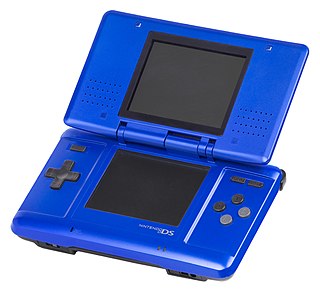
The Nintendo DS is a handheld game console produced by Nintendo, released globally across 2004 and 2005. The DS, an initialism for "Developers' System" or "Dual Screen", introduced distinctive new features to handheld games: two LCD screens working in tandem, a built-in microphone and support for wireless connectivity. Both screens are encompassed within a clamshell design similar to the Game Boy Advance SP. The Nintendo DS also features the ability for multiple DS consoles to directly interact with each other over Wi-Fi within a short range without the need to connect to an existing wireless network. Alternatively, they could interact online using the now-defunct Nintendo Wi-Fi Connection service. Its main competitor was Sony's PlayStation Portable during the seventh generation of video game consoles.

The Rumble Pak is a removable device from Nintendo which provides force feedback while playing video games. Games that support the Rumble Pak cause it to vibrate in select situations, such as when firing a weapon or receiving damage, to immerse the player in the game. Versions of the Rumble Pak are available for the Nintendo 64, the Nintendo DS, and the Nintendo DS Lite. A select few Game Boy Color and Game Boy Advance (GBA) games use a similar technology built into the game cartridge. Force feedback vibration has become a built-in standard feature in almost every home video game console controller since.
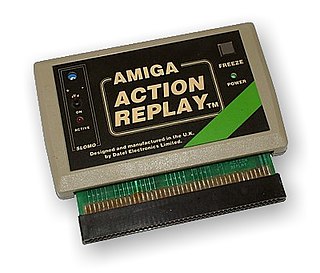
Action Replay is the brand name of a cheating device created by Datel. The Action Replay is available for many gaming systems including the Nintendo DS, Nintendo DSi, Nintendo 3DS, PlayStation Portable, PlayStation 2, GameCube, Game Boy Advance, and the Xbox.
DSI may refer to:
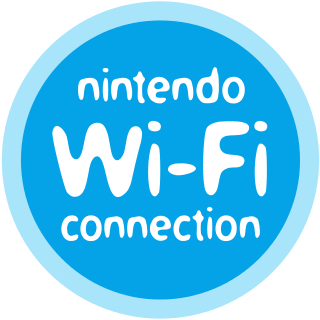
Nintendo Wi-Fi Connection (WFC) was an online multiplayer gaming service run by Nintendo to provide free online play in compatible Nintendo DS and Wii games. The service included the company's Wii Shop Channel and DSi Shop game download services. It also ran features for the Wii and Nintendo DS systems.

The Nintendo DS Lite is a dual-screen handheld game console developed and manufactured by Nintendo. It is the second iteration of the Nintendo DS and is slimmer, brighter, and more lightweight than the original. It was announced on January 26, 2006, more than a month before its initial release in Japan on March 2, 2006 due to overwhelming demand for the original model. It has been released in Australia, North America, Europe, New Zealand, Singapore, and defined regions in South America, the Middle East, and East Asia. As of March 31, 2014, the DS Lite had shipped 93.86 million units worldwide.

The Nintendo DS Browser is a port of the Opera 8.5 web browser for use on the Nintendo DS, developed by Opera Software and Nintendo. Two versions were sold, one for the original Nintendo DS and one for the Nintendo DS Lite, each with a different Slot-2 memory expansion pack to fit the respective system.
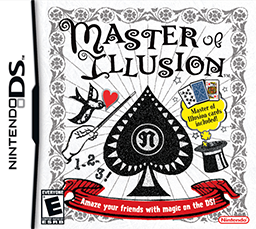
Master of Illusion, known in Europe as Magic Made Fun: Perform Tricks That Will Amaze Your Friends! and in Japan as Magic Encyclopedia, is a magician video game for the Nintendo DS. It was developed by Tenyo and Eighting and published by Nintendo, released in Japan on November 16, 2006, November 26, 2007 in North America and March 14, 2008 in Europe. Around 9 of its magic tricks were released as separate pieces of DSiWare.

The Nintendo DSi is a dual-screen handheld game console released by Nintendo. The console launched in Japan on November 1, 2008, and worldwide beginning in April 2009. It is the third iteration of the Nintendo DS, and its primary market rival is Sony's PlayStation Portable (PSP). The fourth iteration, entitled Nintendo DSi XL, is a larger model that launched in Japan on November 21, 2009, and worldwide beginning in March 2010. Development of the DSi began in late 2006, and the handheld was unveiled during an October 2008 Nintendo conference in Tokyo. Consumer demand convinced Nintendo to produce a slimmer handheld with larger screens than the DS Lite. Consequently, Nintendo removed the Game Boy Advance (GBA) cartridge slot to improve portability without sacrificing durability.
Picopict, known as Pictobits in North America and as Pictopict in Australia, is a puzzle video game developed by Skip Ltd. and published by Nintendo for the Nintendo DSi's DSiWare digital distribution service. It is one of seven games released for the DSi's Art Style series of video games. It was announced on January 26, 2009, was released two days later alongside Somnium, another Art Style game, and was released in North America and PAL regions in the same year, on May 18 and May 22 respectively. In Picopict, players use the touchscreen to move coloured blocks into a formation, such as a four-block line or a 2x2 square. This contributes to an 8-bit image, which consist of various Nintendo Entertainment System (NES) characters, such as Mario, Link, and Bowser.

The Nintendo DSi system software is a set of updatable firmware versions, and a software frontend on the Nintendo DSi video game console. Updates, which are downloaded via the system's Internet connection, allow Nintendo to add and remove features and software. All updates also include all changes from previous updates.
A Nintendo Game Card is a proprietary flash storage-based format used to physically distribute video games for certain Nintendo systems. The game cards resemble both smaller and thinner versions of Hudson's HuCard, the storage medium for the PC-Engine, and the Game Pak ROM cartridges used for previous portable gaming consoles released by Nintendo, such as the Game Boy and Game Boy Advance. The mask ROM chips are manufactured by Macronix and have an access speed of 150 ns.
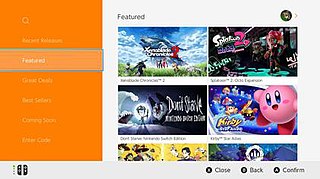
The Nintendo eShop is a digital distribution service powered by the Nintendo Network for the Wii U and Nintendo 3DS, and by a dedicated online infrastructure for the Nintendo Switch. Launched in June 2011 on the Nintendo 3DS, the eShop was enabled by the release of a system update that added the functionality to the Nintendo 3DS's HOME Menu. It is the successor to both the Wii Shop Channel and DSi Shop. Unlike on the Nintendo 3DS, the eShop was made available on the launch date of the Wii U, although a system update is required in order to access it. It is also a multitasking application, which means it is easily accessible even when a game is already running in the background through the system software, though this feature is exclusive to the Wii U and the Nintendo Switch. The Nintendo eShop features downloadable games, demos, applications, streaming videos, consumer rating feedback, and other information on upcoming game releases.
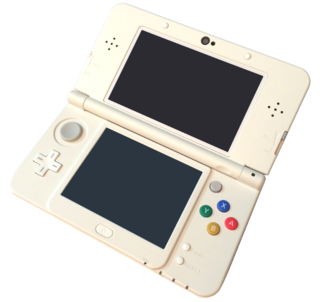
The New Nintendo 3DS is a handheld game console produced by Nintendo. It is the fourth system in the Nintendo 3DS family of handheld consoles, following the original Nintendo 3DS, Nintendo 3DS XL, and Nintendo 2DS. The system was released in Japan on October 11, 2014, in Australia and New Zealand on November 21, 2014, on January 6, 2015 in Europe in a special Club Nintendo-exclusive "Ambassador Edition", and at retail in Europe on February 13, 2015. Like the original 3DS, the New Nintendo 3DS also has a larger variant, the New Nintendo 3DS XL, released in all three regions. In North America, the New Nintendo 3DS XL was released on February 13, 2015, while the standard-sized New Nintendo 3DS was released later on September 25, 2015.